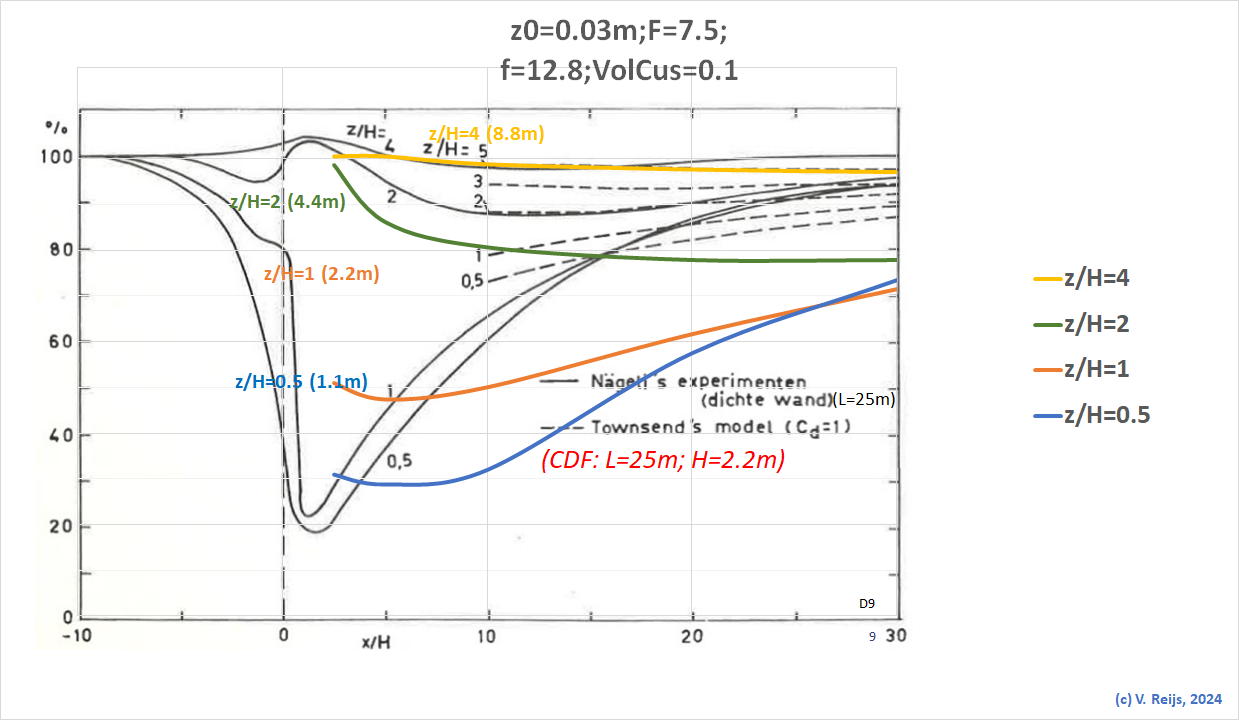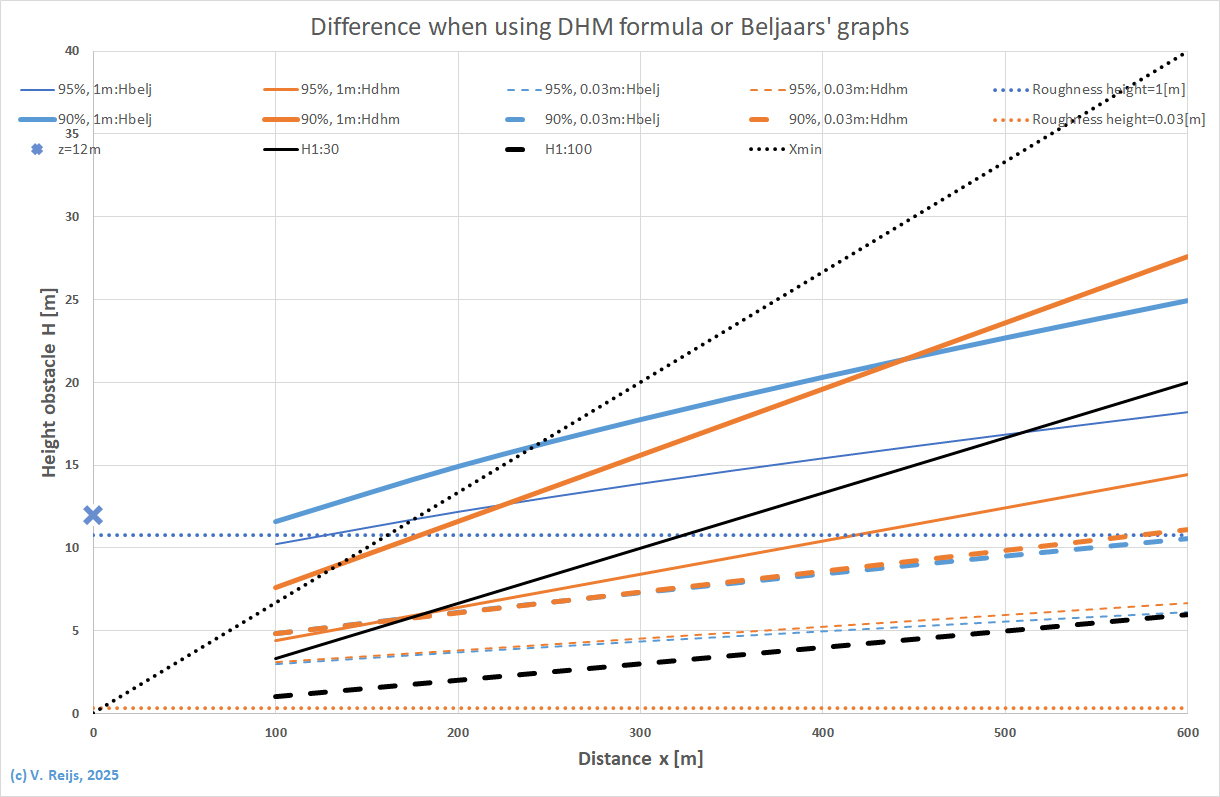Some remarks on the DHM formula
Some remarks on the DHM formula by Victor Reijs
is licensed under CC BY-NC-SA 4.0



Introduction
On this web page the DHM formula will be discussed. It will look at
the background and a possible verification and optimisations of the
formula.
Several questions are
outstanding, see below purple text. If you have input, please
let me know.
Background
According to De
Hollandsche Molen (DHM) windmolenbiotoop
formula (which heavily uses the article
presented by Beljaars [1979]. [Werkgroep Molenbiotoop, 1982,
page 24]) the maximum obstacle height (HDHM) (rekening houdende dat de
windsnelheid tot maximaal 95% mag verlagen [e.g. windenergie
verlaging tot 86%]):
HDHM=x/n
+ c*z
HDHM:
hoogte van een lijn vormig obstakel [m]
x: afstand tussen obstakel en molen [m]
z: hoogte askop [m]
n=50 (bij z0m=1m en 95% windsnelheid verlaging); this
could be called: Wake decay rate
c=0.2 (bij 95% windsnelheid verlaging van 86% energie verlaging)
The conditions are:
- An ABL looks to be use due to logarithmic wind speeds in many
graphs (e.g. Beljaars [1979, page 40 and Fig. 4.8] and z0m
being an explicit parameter.
- The windspeed at shaft height is taken as reference for energy
calculations [Beljaars, 1979, page 8].
- The formula is derived by lineair interpolation when
determining the power loss over the sails' span. The efffect of
the logarithmic ABL is linearilise over the sail span (Figure
A.1).
- Only power loss of 95% and 90% are part of the DHM formula
(Beljaars has a larger range).
- It assumes no obstacles within 100m.
- c is relatively independent on H/z0m.
- A thin long (slightly porous) obstacle with height H has been
used (Beljaars, page 22) to verify Townsend's model. The thin
long obstacle needs to be quite distinct in height from the
rest.
Beside that an extra roughness over a larger area has been
evaluated. While that might be more realistic, the thin long
obstacle provides a better approach when looking at both wind
speed and induced turbulence intensity.
- The real height of the object is input parameter (the
effective height is part of the exprimental results, model aka
formula, if a fence heightens the profile in the same
way as a building!).
Remark: check if the effective
heightening of fence and house-block are simular.
- The tables/graphs/formula are only valid for distance x
longer than the cavity
boundary (x > 15*H) (Beljaars, page 12);
and H larger than 10*z0m (Beljaars, page 15).
Beljaars' boundary migth be related to: The roughness length (z0m)
dictates the roughness
height (ks) at 10* z0m, thus below
that roughness height the formula is not accurate.
- H should not be larger than 2.5*z (for 90%) or 3.5*z (for 95%)
(Beljaars, Figure 5.1).
- The model [Townsend, 1965] has been verify and optimised by
Beljaars with a porous fence ([Nägeli, 1946] optical porosity
between 15% and 20%).
Below picture also includes a comparison with a CFD
simulation of a porous medium (Forchheimer coefficient=12.8;
colored curves).

- So DHM formula is based on a model adjusted to match
experimental in-vivo results of a slightly porous obstacle.
- Trees are not explicitly investigated, but the DHM
formula itself does not disciminated between buildings and trees
(bebouwing- en beplantingshoogte) [Werkgroep
Molenbiotoop, 1982, page 24]
- The functionality of DHM workflow is:
- Model the environment with one obstacles per direction
- Calculate the HDHM
- Determine if height obstacle is heigher than HDHM,
- If the obstacle is higher, the obstacle migth casue a
problem, otherwise it looks ok
- Do this for every direction wanted.
Some typos/errors
A few typos/errors look to exist in the document of Werkrgoep
Molenbiotoop [1982]:
- page 25
replace ''1/n is de
richtingscoefficent van deze lijnstukken."
with "n is het snijpunt van deze lijnstukken met de
horizontale as.".
- page 25
In Afb. 12 the coefficient c is given. These values are rounded
to one decimal. If included 2 decimals we would get '0.25' and
'0.16'. How c is related to speed loss can be found here.
- page 25
replace 'Bovendien is de term c.z vaak groter
dan x/n' with 'Bovendien is de term c.z
vaak kleiner dan x/n'.
- page 25
The statement 'globale benadering van n volstaan' (a global
approach for n is sufficient) does not look to be correct. As n
is depending on H/z0m, it is better to keep this
dependency in the formula. The problem though is that it becomes
an iterative process to derive the H (that might also be the
reason why they used a simpler approach). The evaluation
of introducing this dependency will be done in the
next section.
- page 26
replace 'H = 550/80 x
0,2.12' with 'H = 550/80 + 0,2.12'
- page 26
The derivation for the validity of the DTM formula is valid
(x>15H: looking at cavity boundary).
But there is another aspect that determines the validity of the
DHM formula and that is the non-linear dependency of z/H and x/H
(see Afb. 11), which is assumed linear when just using
the c and n as defined in DHM formula. Better is to determine
the range of real linear part in Afb. 11 and deriving
from that the validity of the DHM formula. This will also be
evaluated in the next
section.
- Beljaars zegt [1979, page 42] dat de gemeten wind door Nägeli
zich sneller hersteld doordat het scherm relatief kort is (25m).
Remark: Dit komt eerder doordat het Nägeli
scherm poreus is.
Most of the above points don't change the formula, except for
points 4 and 6.
Optimisation of the DTM
formula
This secion is heavily based on the results of Beljaar (the DHM
formula uses Beljaars as its basis, except a few simplifications
are introduced in this DHM formula). This section will analyse
these simplifications.
Determing H through new c and n
Still using the DTM formula H =x/n + c.z (x > 15H). But we don't
use a constant c and n, but use logarithmic formulas depending on
H/zo derived from the curves in Afb. 11 [Werkrgoep
Molenbiotoop, 1982] (for 95% and 90&% speed factors) and Table
4.5 to 4.8 [Beljaars, 1979] (for 85%).

Remember
this is though a approximation and migth only work for low
speed losses. More analysis of Beljaars
tables, Nägeli
would be needed.
Using this, we can calculate the H for different distances x. from
the ground-sailer.
The DHM formula values (orange curves)
and the Beljaars graphs (blue curves)
can be seen below.
The thin curves are for a 95% speed factor, the somewhat thicker
curves for 90% and the double curves for 85%.
The dashed curves are for z0m=0.03m while the continuous
curves are for z0m=1m.
De H1:30 and H1:100 curves are applied to the distance between the
obstacle and the mill.

For speed factor of 80% regardless of z0m; Beljaars'
allowable obstacle heights (H) are some 20% higher then DHM's. For
higher speed factors and low z0m (0.03m); Beljaars' and
DHM's results are quite close.
For high z0m (=1m); Beljaars' allowable obstacle heights
are higher then computed by DHM.
Remember the boundaries of Roughness height (ks: above
colored dotted line) and Xmin (>15*H: below black
dotted line).
So the larger z0m, the lower the speed factor or the
smaller x; the larger the absolute difference between Beljaars and
DHM becomes.
Speed loss and speed
factor
When looking at a c (called coefficient by Werkgroep
Molenbiotoop [1982, page 25]) with 1 decimal a liniear formula is
ok-ish: speedloss ~ c/3 and speedfactor ~ 1 - c/3
<this formula is an approximation, assuming an H/z0m
between 15 and 60>
A rewrite of the DHM formule
So one could rewrite DHM formula:
H=x/n(H/zo
) + c*z
c = 3*(1-SpeedFactor)
H=x/n(H/zo ) + 3*(1-SpeedFactor)*z
SpeedFactor= 1-(H - x/n(H/zo ))/3/z
Remember this is though a approximation and might only work for low
speed losses. The factor 3 (SFmultiplier) might be higher/lower.
Reamrk: More analysis of Beljaars tables, Nägeli
and CFD would be needed.
Validity of the DHM formula
x/H(min) (due to non-linar behaviour of z/H and x/H) is one of the
conditions for the validity of the DHM formula (see formula in above table [forth
column]), the other condition is that x > 15H (being beyond the cavity
boundary)
Validation of DHM formula with CFD
A validation is underway, but first a comparision between Beljaars and
CFD.
Conclusions
The larger z0m, the lower the speed factor or the smaller
x; the larger the absolute difference between DHM and Beljaars
becomes. Basing the formula more on the graphs of Beljaars (as also
mentioned in [Werkrgoep Molenbiotoop, 1982, page 24-25]) makes it an
iterative process, which might not be very practical for use.
Luckily in a computer function (Excel/VBA) this is not a real
problem.
IMHO the DHM formula inherits the porosity of Nägeli/Beljaars.
References
Beljaars, A.C.M.: Windbelemmering rond windmolens.
In: (1979).
Judd, M.J. et
al.: A wind tunnel study
of turbulent flow around single and multiple windbreaks,
part I: Velocity fields. In: Boundary-Layer Meteorology
80 (1996), pp. 127-165. Nägeli, Werner
Weitere Untersuchungen über die Windverhältnisse im Bereich von
Windschutzstreifen. In. H. Burger (ed): Mitteilungen der
Schweizerischen Anstalt für das Forstliche Versuchswesen.
1946. pp. 659-737.
Townsend, A.A., The response of a turbulent boundary layer to
abrupt changes in surface conditions, J. Fluid Mech, 22, 199,
1965.
Werkgroep Molenbiotoop: De inrichting van de omgeving van molens.
(1982).
Acknowledgements
I would like to thank people, such as Rien Eykelenboom, and others
for their help, encouragement and/or constructive feedback. Any
remaining errors in methodology or results are my responsibility
of course!!! If you want to provide constructive feedback,
please let me know.
Major content related
changes: May 20, 2024


